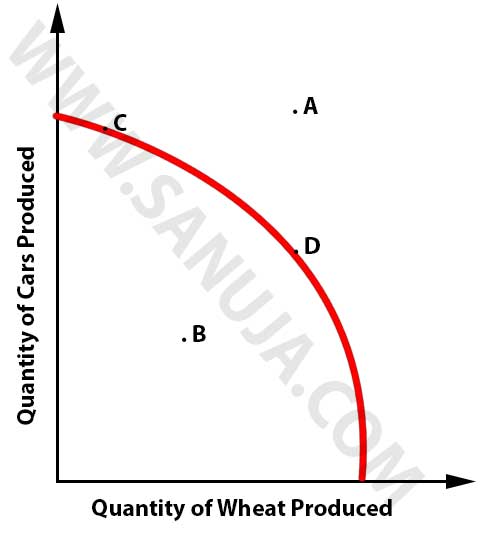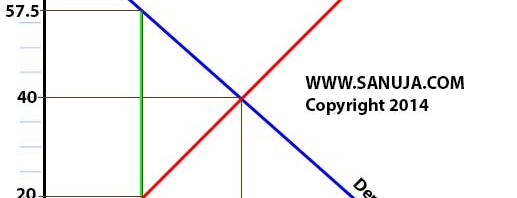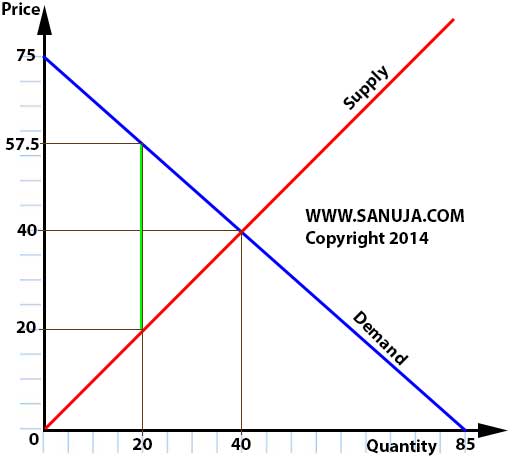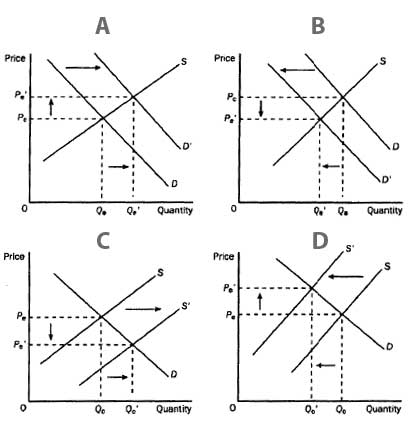Economics 201 is the Principles of Microeconomics class. Depending on the Professor, the exams format may or may not be multiple choice.
Disclaimer: While every reasonable effort is made to ensure that the information provided is accurate, no guarantees for the currency or accuracy of information are made. It takes several proof readings and rewrites to bring the quiz to an exceptional level. If you find an error, please contact me as soon as possible. Please indicate the question ID-Number or description because server may randomize the questions and answers.
Go to: Final Exam
Economics (ECON 201-UCAL) Midterm Exam
Congratulations - you have completed Economics (ECON 201-UCAL) Midterm Exam.
You scored %%SCORE%% out of %%TOTAL%%. With incorrect multiple attempts your score is %%PERCENTAGE%%
Your performance has been rated as %%RATING%%
Question 1 |
A | 6.75% increase |
B | 67.5% increase |
C | 4.5% increase |
D | 0.675% increase |
Question 2 |
A | the amount of money grained from profits. |
B | the main City in a country which produces the most goods. |
C | the amount of created resources. |
D | the amount of money invested. |
Question 3 |
A | ...positive correlation. |
B | ...neutral correlation. |
C | ...negative correlation. |
D | ...random correlation. |
E | ...no correlation. |
Question 4 |
A | $650 |
B | $35.5 |
C | $750 |
D | $57.5 |
E | $20 |
Question 5 |
A | It is a graphical representation of the maximum output obtain from a given unlimited resource base. |
B | It is a graphical representation of the relationship between the output of products and the limited resources available to produce the products. |
C | It is a mathematical model used for determining the inflation rate and its relationship to the economic growth. |
D | It is a mathematical model used for calculating the per unit opportunity cost for a given item. |
E | It is a mathematical model used for determining the inflation rate and its relationship to the unemployment rate. |
Question 6 |
A | 40 - 45% |
B | 15 - 20% |
C | 0% |
D | 30 - 35% |
E | 4 - 6% |
Question 7 |
A | It is the area above the Supply curve and under the market price. |
B | It is the area above the Demand curve and under the market price. |
C | It is the area under the Demand curve and above the market price. |
D | It is the area under the Supply curve and above the market price. |
Question 8 |
A | human resources |
B | capital costs |
C | market fluctuations |
D | non-renewable resources |
Question 9 |
A | ...deadweight loss. |
B | ...elasticity loss. |
C | ...a tax revenue loss. |
D | ...efficiency loss. |
Question 10 |
| Situation | Capital Goods | Consumer Goods |
| A | 0 | 2000 |
| B | 150 | 1750 |
| C | 300 | 1500 |
| D | 550 | 1050 |
| E | 700 | 500 |
| F | 950 | 0 |
A | 150 capital goods |
B | 1050 consumer goods |
C | 550 consumer goods |
D | 550 capital goods |
Question 11 |
A | The price of Orange will decrease as the Apples market is experiencing a s scarcity. |
B | The price of Orange will increase as the Apples market is experiencing a scarcity. |
C | The price of Orange and Apples will decrease. |
D | The price of Orange and Apples will increase. |
E | The inflation rate will increase due to the shortage of Apples. |
Question 12 |
A | most likely a Socialist one. |
B | expanding. |
C | experiencing scarcity. |
D | a failure. |
E | most likely a Capitalist one. |
Question 13 |
A | 1.79 |
B | 2.31 |
C | 1.55 |
D | 2.00 |
E | 0.55 |
Question 14 |
| Situation | Capital Goods | Consumer Goods |
| A | 0 | 2000 |
| B | 150 | 1750 |
| C | 300 | 1500 |
| D | 550 | 1050 |
| E | 700 | 500 |
| F | 950 | 0 |
A | 1/2 Consumer Goods |
B | 300 Capital Goods |
C | 300 Consumer Goods |
D | 150 Capital Goods |
Question 15 |
A | Mark Joseph Carney, the Governor of the Bank of Canada. |
B | Proper Government regulations on the free market economy. |
C | Controls put in placed by the free market "invisible hand". |
D | International trade agreements between Canada and other first world nations, such as NAFTA. |
Question 16 |
A | Increase in the number of substitution products. |
B | Decrease in the number of substitution products. |
C | Decrease in consumer demand. |
D | Increase in consumer income. |
E | Decrease in consumer income. |
Question 17 |
A | True |
B | False |
Question 18 |
A | It is a situation in which a firm exits a market due to financial failure. |
B | It is a situation in which market on its own fails to allocate resources efficiently. |
C | It is a situation in which wrong products and services in the wrong market results in low demand and eventual failure. |
D | It is a situation in which a product or a service failed to generate enough demand to be successful. |
Question 19 |
A | ...decrease the demand for hotdog buns. |
B | ....increase the equilibrium quantity. |
C | ...increase the demand for ketchup. |
D | ...increase the demand for bananas. |
Question 20 |
A | The study of small industries and companies. |
B | The study of behavior of individual agents and markets. |
C | The study of overall production and consumption. |
D | The study of household centered economic systems. |
Question 21 |
| ... | Hours needed for 1 unit | Amount procuded in 24 hours | ||
| Cheese | Jam | Cheese | Jam | |
| Canada | 6 | 2 | 4 | 12 |
| USA | 3 | 4 | 8 | 6 |
A | ...neither and USA has a comparative advantage in Jam. |
B | ...neither and USA has a comparative advantage in Cheese. |
C | ...Cheese and USA has a comparative advantage in Jam. |
D | ...Jam and USA has a comparative advantage in Cheese. |
Question 22 |
A | $710 |
B | $1150 |
C | $1600 |
D | $800 |
E | $575 |
Question 23 |
A | Automobiles |
B | University education |
C | Penicillin antibiotics |
D | Oranges and bananas |
Question 24 |
A | Input: revenue and resource services Output: commodities and costs |
B | Input: income and resource services Output: commodities and consumption |
C | Input: commodities and consumption Output: income and resource services |
D | Input: commodities and costs Output: revenue and resource services |
E | Input: commodities and consumption Output: revenue and resource services |
Question 25 |
A | market power. |
B | private sector regulations. |
C | the invisible hand. |
D | individual property rights. |
E | government intervention. |
Question 26 |
| ... | Hours needed for 1 unit | Amount procuded in 24 hours | ||
| Cheese | Jam | Cheese | Jam | |
| Canada | 6 | 2 | 4 | 12 |
| USA | 3 | 4 | 8 | 6 |
A | ...Cheese and USA has an absolute advantage in Jam. |
B | ...neither good and USA has an absolute advantage in Jam. |
C | ....(cannot be answered due to lack of information). |
D | ...Jam and USA has an absolute advantage in Cheese. |
E | ...neither good and USA has an absolute advantage in Cheese. |
Question 27 |
| ... | Hours needed for 1 unit | Amount procuded in 24 hours | ||
| Cheese | Jam | Cheese | Jam | |
| Canada | 6 | 2 | 4 | 12 |
| USA | 3 | 4 | 8 | 6 |
A | 4 Cheese |
B | 1/3 Cheese |
C | 3/4 Cheese |
D | 4/3 Cheese |
E | 1/3 Cheese |
Question 28 |

A | C and D |
B | D |
C | B |
D | A |
E | A and B |
Question 29 |
A | The value of everything that a producer earns as a result of selling an item. |
B | The amount a seller is paid by the buyer for a given item minus the seller's cost. |
C | The difference between what the buyer's willingness to pay minus the amount the buyer actually pays. |
D | The amount a buyer would gain before the tax being paid. |
Question 30 |
A | ...negative statement. |
B | ...market projection. |
C | ...positive statement. |
D | ...normative statement. |
E | ...economic projection. |
Question 31 |

A | B and C |
B | A |
C | A and B |
D | C and D |
E | B |
Question 32 |
A | ...increase the maintenance budget. |
B | ...decrease the management costs. |
C | ...reduce the quality of pools and facilities. |
D | ...increase the usage fees. |
Question 33 |

A | C |
B | A |
C | A and B |
D | C and D |
E | B |
Question 34 |
A | Graph D |
B | Graph C |
C | Graph B |
D | Graph A |
Question 35 |
A | It will result in larger income gaps between the rich and poor. |
B | It will experience a rapid growth. |
C | It will experience scarcity. |
D | It will result in slow rate of inflation growth. |
E | It will result in a market failure. |
Question 36 |
A | Higher rent with lower quality housing. |
B | Lower rent with higher quality housing. |
C | Higher rent with higher quality housing. |
D | Lower rent with lower quality housing. |
Question 37 |
A | The number of items produced. |
B | The capital needed to produce an item. |
C | The all inputs needed to produce an item. |
D | The added costs such as taxes and transportation fees. |
Question 38 |
A | $3000 |
B | $350 |
C | $700 |
D | $1500 |
Question 39 |
A | $35.5 |
B | $53.5 |
C | $710 |
D | $375 |
Question 40 |
A | Exogenous variables causing the market demand for beef to drop. |
B | Endogenous variables causing the market demand for beef to drop. |
C | Market failure due to Alberta's monopoly on the beef industry. |
D | An example of the "invisible hand" in action. |
E | Externality causing the market to shrink during a crisis. |
Question 41 |
A | ...helping the producers by generating more revenuer. |
B | ...hurting the consumers that needed the most help. |
C | ...creating more competition hence reducing monopolies. |
D | ...creating a fair and balanced economies. |
Question 42 |
A | False |
B | True |
Question 43 |
A | ...change in supply due to change in market prices. |
B | ...change in price due to change in quantity demanded. |
C | ...change in supply due to producer's ability to fulfill the market demand. |
D | ...change in price due to change in market demand. |
E | ...change in supply due to change in market competition. |
Question 44 |
A | $1500 |
B | $800 |
C | $700 |
D | $350 |
Question 45 |
A | ...distorted. |
B | ...artificial. |
C | ...inelastic. |
D | ...elastic. |
Question 46 |
A | The lost time and money from a full time job is the opportunity cost of obtaining an education. |
B | The time spent on studying and attending classes is the capital cost of obtaining an education. |
C | The lost time and money from a full time job is the capital cost of obtaining an education. |
D | The time spent on studying and attending classes is the opportunity cost of obtaining an education. |
E | The cost of obtaining an education is always beneficial compared to having a low paying full time job. Hint: This may be true in most cases. But this is not applicable in all situations. For example; Bill Gates, Mark Zuckerberg, etc. |
Question 47 |
A | ...will help the customers. |
B | ...shortage of goods and increase in demand. |
C | ...abundance of good and decrease in demand. |
D | ...shortage of good decrease in demand. |
Question 48 |
A | ...increased in spending. |
B | ...decrease in demand for the two products. |
C | ...technological breakthrough in one of the two goods. |
D | ...technological breakthrough in both goods. |
E | ...decrease in demand for one product over the other. |
Question 49 |
| ... | Hours needed for 1 unit | Amount procuded in 24 hours | ||
| Cheese | Jam | Cheese | Jam | |
| Canada | 6 | 2 | 4 | 12 |
| USA | 3 | 4 | 8 | 6 |
A | 6 Cheese |
B | 1/3 Cheese |
C | 1 Cheese |
D | 3 Cheese |
E | 4/3 Cheese |
Question 50 |
A | Command economies. |
B | Mixed economies. |
C | Market economies. |
D | Free economies. |
E | Traditional economies. |
← |
List |
→ |
| 1 | 2 | 3 | 4 | 5 |
| 6 | 7 | 8 | 9 | 10 |
| 11 | 12 | 13 | 14 | 15 |
| 16 | 17 | 18 | 19 | 20 |
| 21 | 22 | 23 | 24 | 25 |
| 26 | 27 | 28 | 29 | 30 |
| 31 | 32 | 33 | 34 | 35 |
| 36 | 37 | 38 | 39 | 40 |
| 41 | 42 | 43 | 44 | 45 |
| 46 | 47 | 48 | 49 | 50 |
| End |
Credits: Based on the excellent class notes provided by, Dr. Ronald Schlenker during Summer 2014.
FAQ | Report an Error
If you get a question wrong, you can still click on the other answers. You have multiple opportunities to select the correct answer. This will open up hints and explanations (if available), which will provide additional information.
You may download this exam as a PDF file here.


